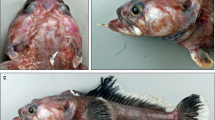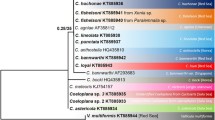Abstract
Phanogenia gracilis sensu lato is a shallow-water crinoid distributed throughout the Indo-western Pacific. The taxonomy of P. gracilis s.l. is clouded by the presence of two distinct morphotypes, each differing in morphology and ecology. The goal was to determine the taxonomic status of P. gracilis s.l. using partial gene sequences of two mitochondrial DNA genes, cytochrome oxidase c subunit I and NADH dehydrogenase subunit II, in conjunction with morphological and ecological data. The molecular phylogenies revealed three lineages separated by 5.0–6.6% corrected genetic distance, which is consistent with the genetic distances among other echinoderm species. Neither morphotype was monophyletic, nor was any examined morphological character exclusive to any one lineage. Discriminant function analysis (DFA) of the morphological and ecological data yielded significant results when grouping P. gracilis by morphotype and by clades recovered in the phylogenetic analyses, but grouping by sample locality was rejected. Although DFA results of grouping by clade were significant, jackknife support was weak, while only correctly grouping specimens by their respective clades 65% of the time. The results suggest the possibility of cryptic species, but additional molecular and morphological data are needed to confirm this. This study demonstrates the need to reevaluate the taxonomy of crinoid species and their respective diagnostic characters.






Similar content being viewed by others
References
Alfaro ME, Zoller S, Lutzoni F (2003) Bayes or bootstrap? A simulation study comparing the performance of Bayesian Markov chain Monte Carlo sampling and bootstrapping in assessing phylogenetic confidence. Mol Biol Evol 20:255–266. doi:https://doi.org/10.1093/molbev/msg028
Bradbury RH, Reichelt RE, Meyer DL, Birtles RA (1987) Patterns in the distribution of the crinoid community at Davies Reef on the central Great Barrier Reef. Coral Reefs 5:189–196. doi:https://doi.org/10.1007/BF00300962
Chen JC, Chang KH, Chen CP (1988) Shallow water crinoids of Kenting National Park, Taiwan. Bull Inst Zool Acad Sin 27(2):73–90
Clark AH (1921) A monograph of the existing crinoids. Bull US Natl Mus 82:1–795 (57 plates)
Clark AH (1931) A monograph of the existing crinoids. Bull US Natl Mus 82:1–816 (82 plates)
Clark HL (1946) The echinoderm fauna of Australia. Publication No. 566. Carnegie Institute of Washington, Washington, DC
Clark AM, Rowe FWE (1971) Shallow-water Indo-west Pacific echinoderms. British Museum: Natural History, London
DeSalle R, Egan MG, Siddall M (2005) The unholy trinity: taxonomy, species delimitation and DNA barcoding. Philos Trans R Soc Lond B Biol Sci 360:1905–1916. doi:https://doi.org/10.1098/rstb.2005.1722
Fabricius KE (1994) Spatial patterns in shallow-water crinoid communities on the Central Great Barrier Reef. Aust J Mar Freshw Res 45:1225–1236. doi:https://doi.org/10.1071/MF9941225
Felsenstein J (1985) Confidence limits on phylogenies: an approach using the bootstrap. Evolution 39:783–791. doi:https://doi.org/10.2307/2408678
Gislén T (1940) A collection of crinoids from the South Sea Islands. Kungl Svenska Vetenskap Handlingar 18:1–16 (3 plates)
Hart MW, Keever CC, Dartnall AJ, Byrne M (2006) Morphological and genetic variation indicate cryptic species within Lamarck’s little sea star, Parvulastra (= Patiriella) exigua. Biol Bull 210:158–167. doi:https://doi.org/10.2307/4134604
Hartlaub C (1891) Beitrag zur Kenntniss der Comatuliden-Fauna des Indischen Archipels. Nova Acta der Kaiserlische Leopoldinisch-Carolinisch Deutschen Akademie der Naturforsche 58:5–120 (5 plates)
Hartlaub C (1893) Beitrag zur Kenntnis der Comatulidenfauna des Indischen Archipels. Nova Acta Kaiserl Leopoldina-Carolinea Deutschen Akad Naturforsch 58:1–120 (5 plates)
Helgen LE, Rouse GW (2006) Species delimitation and distribution in Aporometra (Crinoidea: Echinodermata): endemic Australian featherstars. Invertebr Syst 20:395–414. doi:https://doi.org/10.1071/IS05050
Hillis DM, Bull JJ (1993) An empirical test of bootstrapping as a method for assessing confidence in phylogenetic analysis. Syst Biol 42:182–192. doi:https://doi.org/10.2307/2992540
Huelsenbeck JP, Ronquist F (2001) MRBAYES: Bayesian inference of phylogeny, version 3.0. Bioinformatics 17:754–755. doi:https://doi.org/10.1093/bioinformatics/17.8.754
Huelsenbeck JP, Larget B, Miller RE, Ronquist F (2002) Potential applications and pitfalls of Bayesian inference of phylogeny. Syst Biol 51:673–688. doi:https://doi.org/10.1080/10635150290102366
Kumar S, Tamura K, Jakobsen IB, Nei M (2001) MEGA2: molecular evolutionary genetics analysis software. Bioinformatics 17:1244–1245. doi:https://doi.org/10.1093/bioinformatics/17.12.1244
Lessios HA, Kessing BD, Pearse JS (2001) Population structure and speciation in Tropical seas: global phylogeography of the sea urchin Diadema. Evolution 55:955–975. doi:https://doi.org/10.1554/0014-3820(2001)055[0955:PSASIT]2.0.CO;2
Luning J (1992) Phenotypic plasticity of Daphnia pulex in the presence of invertebrate predators: morphological and life history responses. Oecologia 92:383–390. doi:https://doi.org/10.1007/BF00317464
Marchinko KB (2003) Dramatic phenotypic plasticity in barnacle legs (Balanus glandula Darwin): magnitude, age dependence, and speed of response. Evolution 57:1281–1290
Messing CG (1975) The systematics and distribution of the Crinoidea Comatulida (exclusive of Macrophreatina) collected by the R/V GERDA in the Straits of Florida and adjacent waters. M.S. thesis, University of Miami, 285 p
Messing CG (1994) Comatulid crinoids (Echinodermata) of Madang, Papua New Guinea, and environs: diversity and ecology. In: David B, Guille A, Feral JP, Roux M (eds) Echinoderms through time. Balkema, Rotterdam, pp 237–243
Messing CG (1997) Living Comatulids. In: Waters J, Maples C (eds) Geobiology of Echinoderms. Paleontological Society Paper No. 3. Paleontological Society, Baltimore, pp 3–30
Messing CG (1998a) An initial re-assessment of the distribution and diversity of the East Indian shallow-water crinoid fauna. In: Mooi R, Telford M (eds) Echinoderms: San Francisco. Balkema, Rotterdam, pp 187–192
Messing CG (1998b) Revision of the recent Indo-West Pacific comatulid genus Comaster Agassiz. Part 1. The type species of Comaster and Phanogenia Lovén (Echinodermata: Crinoidea: Comasteridae). Invertebr Taxon 12:191–209. doi:https://doi.org/10.1071/IT97004
Messing CG (2001) A key to the genera of Comasteridae (Echinodermata: Crinoidea) with the description of a new genus. Bull Biol Soc Wash 10:277–300
Messing CG (2003) Unique morphology in the living bathyl feather star, Atelecrinus (Echinodermata: Crinoidea). Invertebr Biol 122:280–292
Messing CG (2007) The crinoid fauna (Echinodermata: Crinoidea) of Palau. Pac Sci 61(1):91–111. doi:https://doi.org/10.1353/psc.2007.0010
Meyer DL (1973) Feeding behavior and ecology of shallow-water unstalked crinoids (Echinodermata) in the Caribbean Sea. Mar Biol (Berl) 22:105–129. doi:https://doi.org/10.1007/BF00391776
Meyer DL, Macurda DB (1980) Ecology and distribution of shallow-water crinoids of Palau and Guam. Micronesica 16:59–99
Mittelbach GG, Osenberg CW, Wainwright PC (1999) Variation in feeding morphology between pumpkinseed populations: phenotypic plasticity or evolution. Evol Ecol Res 1:111–128
Nicholas KB, Nicholas HB Jr (1997) A tool for editing and annotating multiple sequence alignments. Distributed by the authors
Posada D, Buckley TR (2004) Model selection and model averaging in phylogenetics: advantages of the AIC and Bayesian approaches over likelihood ratio tests. Syst Biol 53:793–808. doi:https://doi.org/10.1080/10635150490522304
Posada D, Crandall KA (1998) Modeltest: testing the model of DNA substitution. Bioinformatics 14:817–818. doi:https://doi.org/10.1093/bioinformatics/14.9.817
Puorto G, Da Graca SM, Theakston RDG, Thorpe RS, Warrell DA (2001) Combining mitochondrial DNA sequences and morphological data to infer species boundaries: phylogeography of lancehead pitvipers in the Brazilian Atlantic forest, and the status of Bothrops pradoi (Squamata: Serpentes: Viperidae). J Evol Biol 14:527–538. doi:https://doi.org/10.1046/j.1420-9101.2001.00313.x
Rowe FWE, Hoggett AK, Birtles RA, Vail LL (1986) Revision of some comasterid genera from Australia (Echinodermata: Crinoidea), with descriptions of two new genera and nine new species. Zool J Linn Soc 86:197–277. doi:https://doi.org/10.1111/j.1096-3642.1986.tb01812.x
Sites JW Jr, Crandall KA (1997) Testing species boundaries in biodiversity studies. Conserv Biol 11:1289–1297
Stoletzki N, Schierwater B (2005) Genetic and color morph differentiation in the Caribbean sea anemone Condylactis gigantean. Mar Biol (Berl) 147:747–754. doi:https://doi.org/10.1007/s00227-005-1620-y
Swofford DL (2002) PAUP* phylogenetic analysis using parsimony, (*and other methods), version 4.0b10. Sinauer, Sunderland
Thompson JD, Gibson TJ, Plewniak F, Jeanmougin F, Higgins DG (1997) The ClustalX windows interface: flexible strategies for multiple sequence alignment aided by quality analysis tools. Nucleic Acids Res 25:4876–4882. doi:https://doi.org/10.1093/nar/25.24.4876
Trussell GC (2000) Phenotypic clines, plasticity, and morphological trade-offs in an intertidal snail. Evolution 54:151–166
Wiens JJ (2004) The role of morphological data in phylogeny reconstruction. Syst Biol 53:653–661. doi:https://doi.org/10.1080/10635150490472959
Will KW, Mishler BD, Wheeler QD (2005) The perils of DNA barcoding and the need for integrative taxonomy. Syst Biol 54:844–851. doi:https://doi.org/10.1080/10635150500354878
Wilson NG, Hunter RL, Lockhart SJ, Halanych KM (2007) Multiple lineages and absence of panmixia in the “circumpolar” crinoid Promachocrinus kerguelensis from the Atlantic sector of Antarctica. Mar Biol (Berl) 152:895–904. doi:https://doi.org/10.1007/s00227-007-0742-9
Zmarzly DL (1985) The shallow-water crinoid fauna of Kwajalein Atoll, Marshall Islands: ecological observations, interatoll comparisons, and zoogeographic affinities. Pac Sci 39:340–358
Acknowledgments
We would like to thank the South Australian Museum, and Patrick and Lori Colin and Laura Martin of the Coral Reef Research Foundation, Koror, Palau, for the loan of specimens. We would also like to thank Andrea Scouras of Simon Fraser University for advice toward primer design and access to unpublished data, Vince Richards for the help with project design and data analysis, and the three anonymous reviewers for their constructive comments. This research was supported by a Nova Southeastern University President’s Faculty Research and Development Grant (2004–2005; Charles G. Messing and Mahmood S. Shivji) and an Australian Biological Resources Study Participatory Program Research Grant (Greg W. Rouse and Charles G. Messing).
Author information
Authors and Affiliations
Corresponding author
Additional information
Communicated by U. Sommer.
Rights and permissions
About this article
Cite this article
Owen, C.L., Messing, C.G., Rouse, G.W. et al. Using a combined approach to explain the morphological and ecological diversity in Phanogenia gracilis Hartlaub, 1893 (Echinodermata: Crinoidea) sensu lato: two species or intraspecific variation?. Mar Biol 156, 1517–1529 (2009). https://doi.org/10.1007/s00227-009-1173-6
Received:
Accepted:
Published:
Issue Date:
DOI: https://doi.org/10.1007/s00227-009-1173-6




